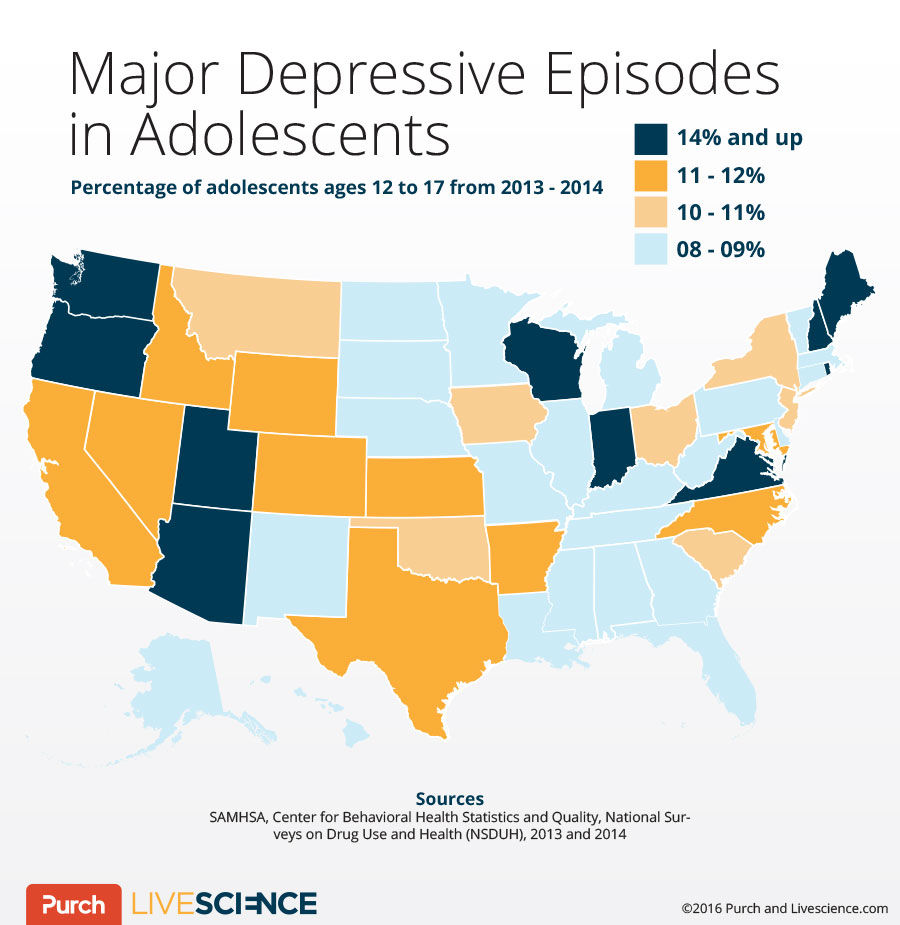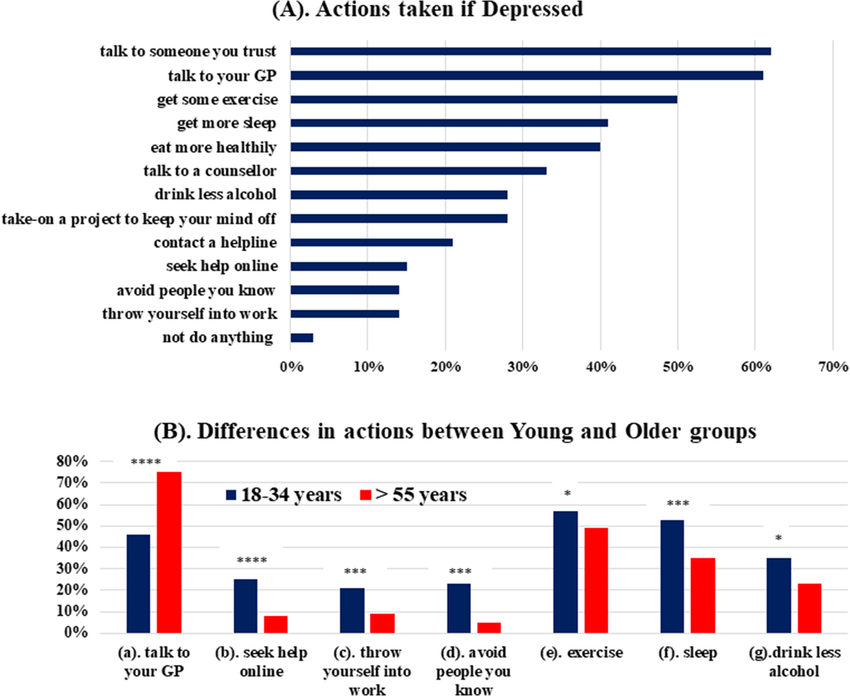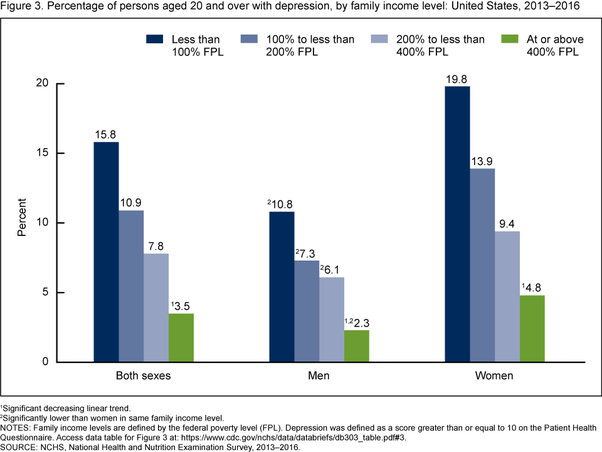Depression Rates Are Higher In Females And Gender Minority Teens
While depression can affect teens of any sex and gender identity, a study published by the JAMA Network found that by 15 years old, females were twice as likely to have experienced episodic depression than males.
When comparing male and female depression rates, depression continues to present at a higher rate in females than males from the teen years into adulthood.
Also, according to the , risk factors leading to depression are highest among adolescents and young adults who identify with a gender minority, such as transgender, genderqueer, and nonbinary.
Depression And Heart Disease: The Heart And Soul Study
The Heart and Soul Study is an ongoing project led by VA and University of California, San Francisco, researchers. It is helping to determine how psychological factors influence the outcomes of patients with coronary heart disease.
A total of 1,024 patients in the San Francisco area, including 440 Veterans, were enrolled in the study between 2000 and 2002. Researchers have followed them ever since to understand the association between psychological factors and cardiovascular events.
A 2008 paper by study researchers, published in the Journal of the American Medical Association, provided evidence that the link between depression and heart disease may hinge largely on behavioral factors associated with depression, such as lack of exercise and increased rates of smoking.
The most recent study by the Heart and Soul team, published in 2016, further explored whether depression is mainly a cause or a consequence of poor health behaviors.
Rates And Statistics For Suicide In The United States
Information presented in this article may be triggering to some people. If you are having suicidal thoughts, contact the National Suicide Prevention Lifeline at 1-800-273-8255 for support and assistance from a trained counselor. If you or a loved one are in immediate danger, call 911.
For more mental health resources, see our National Helpline Database.
Suicides in the United States have been on the rise, up 33% from 1999 through 2017, and the pace of the increase has been rising since 2006. In 2016, suicide ranked as the 10th leading cause of death among Americans. It is the second leading cause of death for those under the age of 35.
The annual suicide rate in the U.S. is over 14 deaths per 100,000 population.
Nearly 47,000 people died from suicide in 2017. According to the CDC, one person dies from suicide every 11 minutes.
You May Like: Does Depression Come In Cycles
% Of Americans Suffer From Seasonal Depression
Women are more likely to suffer from this type of depression. Namely, depression stats show that 4 out of 5 people with this mental disorder are women. Seasonal depression is also known as seasonal affective disorder , and its a type of depression thats triggered by seasonal changes. Typically, people with SAD start experiencing depressive episodes in the fall.
How Is Depression Syndrome Treated

Depression can be serious, but its also treatable. Treatment for depression includes:
- Self-help: Regular exercise, getting enough sleep, and spending time with people you care about can improve depression symptoms.
- Counseling: Counseling or psychotherapy is talking with a mental health professional. Your counselor helps you address your problems and develop coping skills. Sometimes brief therapy is all you need. Other people continue therapy longer.
- Alternative medicine: People with mild depression or ongoing symptoms can improve their well-being with complementary therapy. Therapy may include massage, acupuncture, hypnosis and biofeedback.
- Medication: Prescription medicine called antidepressants can help change brain chemistry that causes depression. Antidepressants can take a few weeks to have an effect. Some antidepressants have side effects, which often improve with time. If they dont, talk to your provider. A different medications may work better for you.
- Brain stimulation therapy: Brain stimulation therapy can help people who have severe depression or depression with psychosis. Types of brain stimulation therapy include electroconvulsive therapy , transcranial magnetic stimulation and vagus nerve stimulation .
Also Check: Why Does Anxiety Cause Depression
Depression In Older Adults: More Facts
Depression affects more than 19 million Americans every year, regardless of age, race, or gender. While depression is not a normal part of the aging process, there is a strong likelihood of it occurring when other physical health conditions are present. For example, nearly a quarter of the 600,000 people who experience a stroke in a given year will experience clinical depression. Unfortunately, symptoms of depression are often overlooked and untreated when they coincide with other medical illnesses or life events that commonly occur as people age . However, clinical depression is never a normal response it is a serious medical illness that should be treated at any age.
Prevalence
- More than two million of the 34 million Americans age 65 and older suffer from some form of depression.
Co-occurring Illnesses
- Symptoms of clinical depression can be triggered by other chronic illnesses common in later life, such as Alzheimers disease, Parkinsons disease, heart disease, cancer and arthritis.
Widowhood
- One-third of widows/widowers meet criteria for depression in the first month after the death of their spouse, and half of these individuals remain clinically depressed after one year.
Healthcare Costs
- Older patients with symptoms of depression have roughly 50% higher healthcare costs than non-depressed seniors.
Suicide
Treatment
Disruptive Mood Dysregulation Disorder
Disruptive mood dysregulation disorder is a condition that occurs in children and youth ages 6 to 18. It involves a chronic and severe irritability resulting in severe and frequent temper outbursts. The temper outbursts can be verbal or can involve behavior such as physical aggression toward people or property. These outbursts are significantly out of proportion to the situation and are not consistent with the childs developmental age. They must occur frequently and typically in response to frustration. In between the outbursts, the childs mood is persistently irritable or angry most of the day, nearly every day. This mood is noticeable by others, such as parents, teachers, and peers.
In order for a diagnosis of disruptive mood dysregulation disorder to be made, symptoms must be present for at least one year in at least two settings and the condition must begin before age 10. Disruptive mood dysregulation disorder is much more common in males than females. It may occur along with other disorders, including major depressive, attention-deficit/hyperactivity, anxiety, and conduct disorders.
Disruptive mood dysregulation disorder can have a significant impact on the childs ability to function and a significant impact on the family. Chronic, severe irritability and temper outbursts can disrupt family life, make it difficult for the child/youth to make or keep friendships, and cause difficulties at school.
Treatment typically involves and/or medications.
Also Check: How Much 5 Htp Should I Take For Depression
Depression Statistics In America
- 17.3 million adults have had at least one major depressive episode.
- Of those with major depressive episodes, 63.8% of adults and 70.77% of adolescents had severe impairment.
- Women are nearly twice as likely as men to have depression.
- Major depressive episodes were most prevalent among adults and adolescents reporting two or more races.
In The Past Year As Many As 11 Million Us Adults Had An Episode That Led To Severe Impairment
Statistics about depression remark that an impressive number of Americans had episodes that resulted in impairments. Generally, a depressive episode is characterized by at least two weeks of low mood and lost interest in almost everything, significantly affecting ones quality of life. Namely, a person can have problems with eating, energy, sleep, concentration, or self-worth.
Recommended Reading: Can A Woman Have Postpartum Depression After A Miscarriage
About 25% Of Patients Admitted To A Hospital Due To Depression Have Psychotic Depression
According to depression statistics, over time, quite a number of people might develop symptoms of depression. Whats more, 1 in 13 people will experience a psychotic episode before age 75. Finally, it is important to note that psychotic depression is a severe mood disorder, the symptoms of which can include hallucinations, delusions, or paranoia.
The Top 10 Depression Stats Everyone Should Know
- In 2020, 27.8% of American adults claimed to be struggling with the symptoms of depression during the pandemic.
- Over 300 million people suffer from depression worldwide.
- The US is third worldwide in relation to the overall burden of depression.
- About 15% of adults will experience depression at least once in their lives.
- 5% of Americans suffer from seasonal depression.
- 2.8% of Americans suffer from bipolar disorder.
- About 50% of new mothers diagnosed with postpartum depression experienced some of the symptoms during pregnancy.
- Treatment for depression proved effective in up to 80% of the cases within 46 weeks.
- Almost 800,000 people all over the world commit suicide every year.
- US employers lose about $100 billion every year due to depression.
Recommended Reading: What To Do When Your Depression Gets Bad
About Half Of Women Diagnosed With Ppd Began Experiencing Symptoms During Pregnancy
While its common for women to have some symptoms of depression after giving birth, postpartum depression statistics confirm that PPD can be much more severe. A point often overlooked is that several reports and studies have found that these symptoms might appear earlier than we expectduring pregnancy.
Data Source And Methods

Data from the 2019 National Health Interview Survey data were used for this analysis. NHIS is a nationally representative multipurpose health survey of the civilian noninstitutionalized U.S. population. It is conducted continuously throughout the year by the National Center for Health Statistics . Interviews are conducted in the respondents home, but follow-ups to complete interviews may be conducted by telephone when necessary. For more information about NHIS, visit:
Point estimates and the corresponding variances were calculated using SAS-callable SUDAAN version 11.0 to account for the complex sample design of NHIS. Linear, quadratic, and cubic trends by age were evaluated using orthogonal polynomials in logistic regression. Differences between percentages were evaluated using two-sided significance tests at the 0.05 level. All estimates presented meet NCHS data presentation standards for proportions .
Recommended Reading: Bipolar Depression And Anxiety Treatment
If Left Untreated Severe Depression Can Lead To Developing Serious Health Conditions
Many people around the world tend to overlook the disorder. It is worth noting that, if left untreated or undertreated, it can bring about other conditions. That said, according to the World Health Organization, one could look into a number of treatmentsmedication, diet, therapy, exercisingto find the ones that work for them and decrease the risk of developing other conditions.
Statistical Methods And Measurement Caveats
Diagnostic Assessment:
Population:
- The entirety of NSDUH respondents for the major depressive episode estimates is the civilian, non-institutionalized population aged 12-17 and 18 years old or older residing within the United States.
- The survey covers residents of households and persons in non-institutional group quarters .
- The survey does not cover persons who, for the entire year, had no fixed address were on active military duty or who resided in institutional group quarters .
- Some adults and adolescents in these excluded categories may have had a major depressive episode in the past year, but they are not accounted for in the NSDUH major depressive episode estimates.
- Sex was recorded by the interviewer.
Interview Response and Completion:
- In 2019, 35.1% of the selected NSDUH sample did not complete the interview.
- Reasons for non-response to interviewing include: refusal to participate respondent unavailable or no one at home and other reasons such as physical/mental incompetence or language barriers .
- Adults and adolescents with major depressive episode may disproportionately fall into these non-response categories. While NSDUH weighting includes non-response adjustments to reduce bias, these adjustments may not fully account for differential non-response by mental illness status.
Please see the 2019 National Survey on Drug Use and Health Methodological Summary and Definitions report for further information on how these data were collected and calculated.
Read Also: I Am Depressed In My Marriage
What Are The Symptoms Of Depression
Depression can affect your emotions, mind and body. Depression symptoms include:
- Feeling very sad, hopeless or worried.
- Not enjoying things that used to give you joy.
- Being easily irritated or frustrated.
- Eating too much or too little.
- Changes in how much you sleep.
- Having a difficult time concentrating or remembering things.
- Experiencing physical problems like headache, stomachache or sexual dysfunction.
- Thinking about hurting or killing yourself.
If you or someone you know has thoughts of hurting themselves, please call the National Suicide Prevention Lifeline at 800.273.8255. This national network of local crisis centers provides free, private emotional support to people in suicidal crisis or emotional distress 24 hours a day, seven days a week.
Depression Prevalence In The Us
According to the National Institute of Mental Health, an estimated 17.3 million adults in the United States had at least one major depressive episode in 2017 based on the most recent data from the National Survey on Drug Use and Health . Even more people suffer from seasonal affective disorder.
According to the most recent data from the Centers for Disease Control and Prevention , depression in the U.S. is lower among non-Hispanic Asian adults, compared to Hispanic, non-Hispanic black, or non-Hispanic white adults. Additionally, 15.8% of adults from families living below the poverty line have depression, and the prevalence decreased among adults as family income levels increased.
About 65% of those diagnosed with depression received treatment, with 44% receiving combine care by a health professional and medication. 15% of those with major depression received treatment from a health professional only and 6% received mediation treatment only. 35% of those who have major depression did not receive treatment. About 50% of those diagnosed with depression in the U.S. are also diagnosed with anxiety.
A study by Quote Wizard analyzed CDC data from 2014 to 2018 to find the prevalence of depression in all 50 states. Rankings presented are based on the five-year average in each state.
You May Like: Why Is Depression And Anxiety So Common
Depression Among Veterans And Non
A team from the VA Palo Alto Health Care System and Stanford University School of Medicine examined data on 7,000 men age 50 or older in a study published in 2014, and found that Veterans were no more likely than non-Veterans to have depression or anxiety.
Because Veterans, especially those who served in combat, have generally experienced more stress and trauma in their lives than non-Veterans, the team had expected to see higher rates of depression among Veterans. Instead, they found just the opposite. Older Veterans actually scored better than non-Veterans in the same age group.
The team found 11 percent of Veterans reported elevated rates of depression, compared with 12.8 percent of non-Veterans. For anxiety, 9.9 percent of Veterans reported elevated levels, versus 12.3 percent for non-Veterans. These differences were not considered statistically significant.
Vietnam Veterans, however, were twice as likely to have elevated depression and anxiety than World War II or Korean War Veterans in the study. The team suggested further studies are needed to determine why this was true.
The Disorder Is Most Common In Young Adults Aged 1825
Depression statistics for college students remark that young adults are very likely to experience depression. Namely, 10.9% of those aged 1825 experience it. Stress with school, financial problems, and moving away from friends and family do impact ones wellbeing and increase the likelihood of developing the disorder.
Read Also: Natural Ways To Treat Depression
Depression Statistics Everyone Should Know
Steven Gans, MD is board-certified in psychiatry and is an active supervisor, teacher, and mentor at Massachusetts General Hospital.
Depression affects people from all walks of life, no matter their background. It can affect people of all ages as well. Unfortunately, theres still a stigma that surrounds mental health issues, and some people view disorders like depression as a weakness. But, similar to the way anyone can develop certain physical health issues, mental health issues arent always preventable.
Understanding the latest depression statistics could increase awareness about mental health, and recognizing how widespread it is could also help reduce the stigmawhich might encourage more people to seek treatment.
Suicide Rate Statistic Breakdowns

When the suicide rate is broken down by demographics, important information can be observed. For example:
- The suicide rate is four times higher for males than females. In the United States, male deaths make up almost 80% of all suicide deaths.
- Suicide is attempted three times as often by females women are also more likely to have suicidal thoughts.
- Firearms are the most common cause of death for males.
- Poisoning is the most common cause of death for females.
- Lesbian, gay, and bisexual kids are three times more likely to attempt suicide than heterosexual kids.
- 41% of trans adults attempt suicide.
- The suicide rate is 1.8 times higher in rural areas than in urban areas.
- The suicide rate is highest among middle-aged white males. A 2015 study in the Proceedings of the Natural Sciences found that the suicide rate among white, middle-aged American men has increased dramatically in recent years.
- Among Native Americans and Alaska Natives, suicide is the eighth leading cause of death across all ages. For the age group 15 to 34 of Native Americans and Alaska Natives, suicide jumps to the second leading cause of death.
Suicide statistics by age group have been consistent for several years. Broken down by age group across all racial and ethnic groups, suicide as a leading cause of death ranked as follows:
| Age Group | |
| 65 and older | 17th |
Recommended Reading: How Can You Heal Depression